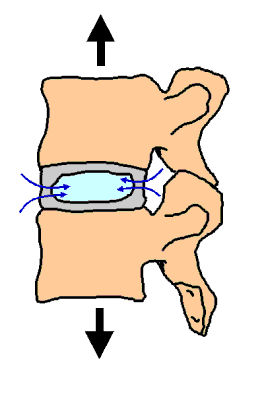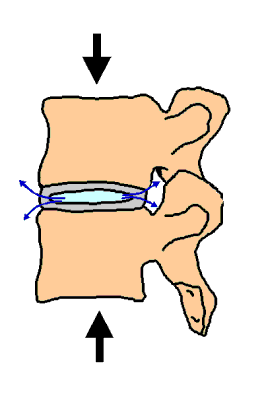
Here is why-
No Movement starves your discs!
In humans over 5 years of age, there is no direct blood supply to the jelly like nucleus of the
intervertebral discs(6). The intervertebral discs therefore rely upon fluid inflow and outflow for
their nutrition: when you lie down, the pressure comes off the discs and they expand, absorbing
water and nutrients as they do so (rather like a sponge expanding and sopping up a spill on the
floor). When you stand up, the discs are compressed and their watery component is squeezed
out, thus removing waste products at the same time (see pictures of disc squeeze/expand
cycles to right). Similar squeeze/expand cycles are occurring every time that we move, both day
and night. This is not just an academic finding! You must move in order to “feed” your discs and
keep them healthy. The disc squeeze/expand cycle is crucial to spinal health. It is well proven that
your degenerative disc "disease" progresses faster over time if your discs can't alternate compression
with expansion.
Consider the following findings:-
- Astronauts complain of back pain and siatic pain after prolonged periods of weightlessness (Nixon 1986,
quoted in ref 1).
- Well exercised dogs have better nourished discs when compared with sedentary dogs. (Holm,
Nachemson1983, quoted in ref. 1). Note that dogs have degenerative disc disease and lumbar pain just as humans do - in dogs however, the pinched nerve pain is higher than in humans, affecting T13-L5 rather than the siatic nerve roots.
- Static seating postures cause discomfort and joint and nerve health risks. (Aaras, Horgen, Ro, 2000, quoted in
ref. 2).
- Sitting more than half the time at work is associated with herniated discs and siatic nerve pain in those older than 35.
(Kelsey, 1975 quoted in ref. 2).
- People in seated occupations (office workers and commercial drivers) have a greater frequency
of lower back pain/siatic pain. (Aaras AH, Horgen G, Ro O, 2000 quoted in ref. 1).
- Workers who sit in fixed postures experience more discomfort and chronic disorders such as sciatic pain
(Graf et al,
1995 quoted in ref.2) and movement reduces these risks.(Aaras et al. 1997, quoted in ref. 2).
|
Diagram 1: Unloaded disc filling with nutrient rich fluid:-

Diagram 2: Loaded Disc emptying of waste laden fluid:-

The Back Maintenance Manual - for Lower Back Pain
Learn more!

|
The following table gives some indication of just how bad the lack of movement associated with
chair sitting is for pain to do with the lumbar spine and siatic nerve:
Table:-
Percent of back pain patients that reported worsening of their lower back pain/siatic nerve pain while performing a given activity.
| Activity. |
Percentage of back patients reporting pain during activity. |
Number of Spinal Rotations / second while performing the activity. |
| Sitting |
81 |
0.1 |
|
Standing |
75 |
0.2 |
| Lying |
47 |
.35 |
| Walking |
22 |
0.8 |
| Cycling |
17 |
1 |
|
Ref(1)
Summary:
In order to minimize the consequences of office chair sitting in terms of Degenerative Disc Disease and Siatic Nerve Pain
, you need to move as you sit.
If you move while you sit, you will:-
- "Feed your discs" and keep them healthy.
- Minimize the risk of lower lumbar disc herniation severe enough to pinch the siotic nerve.
- Avoid ongoing pinched siatic nerve pain that is worsened by sitting.

Consequences of Office Chair Sitting
(1):
Degenerative Disc Disease, Siatic Nerve Pain, Siotic Nerve Pain
Office Chair Sitting: Page 1 | Page 2 |
Page 3

Return to top...
© Bruce Thomson, EasyVigour Project
|
|
|
|
|